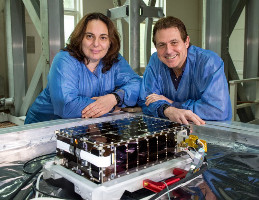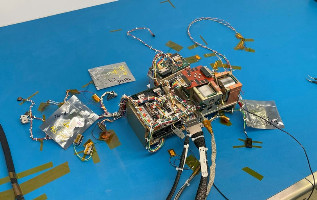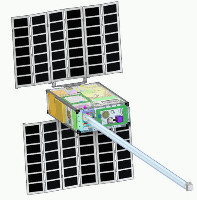| Name | Dione |
|---|---|
| Form factor | CubeSat |
| Units or mass | 6U |
| Status | not launched, expected in 2025 |
| Launcher | Falcon 9, (Transporter-14) |
| Organization | NASA Goddard Space Flight Center |
| Institution | Space agency |
| Entity type | Government (Civil / Military) |
| Nation | US |
| Launch brokerer | NASA CSLI / ELaNa |
| Partners | Utah State University, Virginia Tech |
| Oneliner |
Study how Earth’s upper atmospheric layers react to the ever-changing flow of solar energy into the magnetosphere. |
| Description |
Scientific investigation heliophysics mission that will study the responses of the ionosphere-thermosphere (IT) system to magnetospheric energy input and, in turn, enable their better forecast and prediction. Magnetospheric energy input deposited to the upper atmosphere affects human assets in low-Earth orbit and on the ground. Understanding the fundamental processes of the energy deposition and IT responses is the path for developing better specification and forecast models for space weather. Called Dione after the ancient Greek goddess of the oracles, will carry four miniaturized instruments to study how Earth’s upper atmospheric layers react to the ever-changing flow of solar energy into the magnetosphere — the enveloping bubble of magnetic field around Earth that deflects most of the particles that erupt from the Sun. Earth’s upper atmosphere is where most low-Earth-orbiting satellites reside, and their orbits are strongly affected by sudden density changes created by space weather. Expected to launch in 2022, Dione will help give scientists insights into these physical processes — which contribute to atmospheric drag, a process that causes low-Earth-orbiting satellites to prematurely reenter the atmosphere — and provide data needed to improve space weather forecasts. The pathfinding Dione spacecraft is a prototype. It would complement the conceptual Geospace Dynamics Constellation, a mission proposed by the 2013 Heliophysics Decadal Survey, which, if developed, would gather similar data from multiple similarly equipped spacecraft, Zesta said. “Our team wants to show we can do this type of measurement with a CubeSat and eventually fly Dione-type spacecraft in a constellation,” Zesta said. Three of the instruments will be provided by Goddard; all were developed with funding from Goddard’s Internal Research and Development program and all have either flown or are slated to fly during upcoming CubeSat or suborbital missions. They include a flight-proven fluxgate magnetometer, which debuted on Dellingr’s maiden flight, and the Ion-Neutral Mass Spectrometer (INMS), another instrument that flew on Dellingr as well as on a National Science Foundation-funded mission called ExoCube. On both Dellingr and ExoCube, the INMS was slated to measure the matter that creates atmospheric drag on satellites. Goddard’s third contribution, the Dual Electrostatic Analyzer will fly on Endurance, a pioneering mission that will directly measure a particular component of Earth’s electrical field generated in the ionosphere. Utah State University and Virginia Tech are providing the fourth instrument, the Gridded Retarding Ion Distribution Sensor (GRIDS). GRIDS is designed to measure the distribution, motion, and velocity of ions and will fly on the Goddard-developed PetitSat mission scheduled to launch in 2021. |
| Sources | [1] [2] [3] [4] [5] |
| Photo sources | [1] [2] |
Last modified: 2025-04-22



